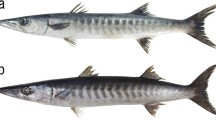Abstract
Twelve morphological characteristics in 61 fossil crayfish specimens, which came from the Upper Jurassic Yixian Formation, are discussed respectively in the present paper. A study of these new and better preserved materials allows us to add to and revise the original description for Family Cricoidoscelosidae. In our collection, no modifications of the second pleopod of the males have yet been noted. This would be a crucial factor for the diagnosis of the family. Based on the presence of annulus ventralis in bothCricoidoscelosus andPalaeocambarus, they would appear to be very closely allied to those characteristics of the Family Cambaridae. In regard to the family Protastacidae, we seriously doubt it is actually crayfish, in light of the lack of any apomorphies identifiable within the Astacida, and their marine habitat.
Similar content being viewed by others
References
Taylor, R. S., Schram, F. R., Shen, Y. B., A new crayfish Family (Decapoda: Astacida) from the Upper Jurassic of China, with a reinterpretation of other Chinese crayfish taxa, Paleontological Research, 1999, 3(2): 121.
van Straelen, V., On fossil freshwater crayfish from eastern Mongolia, Bulletin of the Geological Society of China, 1928, 7: 133.
Imaizumi, R., Fossil crayfishes from Jehol, Science Reports of the Tohuku Imperial University (Ser. 2 Geol.), 1938, 19: 173.
Albrecht, H., Die Protastacidae n. fam., fossile Vorfahren der Flusskrebse? Neues Jahrbuch für Geologie und Palantologie, Monatshefte, 1983, Hl: 5.
Hobbs, Jr. H. H., Synopsis of the families and genera of the crayfishes (Crustacea: Decapoda), Smithsonian Contributions to Zoology, 1974, 164: 1.
Hobbs, Jr. H. H., An illustrated checklist of the American crayfishes (Decapoda: Astacidae, Cambaridae, and Parastacidae), Smithsonian Contributions to Zoology, 1989, 480: 1.
Scholtz, G., Von Zellen und Kontinenten-die Evolution der Flusskrebse (Decapoda, Astacida), Zuglich Kataloge des OO, Landesmuseums, Neue Folge Nr, 1998, 137: 205.
Hof, C. H. J., Briggs, D. E. G., Decay and mineralization of mantis shrimps (Stomatopoda: Crustacea)—a key to their fossil record, Palaios, 1997, 12: 420.
Holdich, D. M., Deeve, I. D., Functional morphology and anatomy, Freshwater crayfish: Biology, Management and Exploitation (eds. Holdich, D. M., Lowery, R. S.), London: Croom Helm, 1988, 11–51.
Schram, F. R., Shen, Y. B., An unusual specimen of fossil crayfish molt, Acta Palaeontologica Sinica, 2000, 39(3): 416.
Author information
Authors and Affiliations
About this article
Cite this article
Shen, Y., Schram, F.R. & Taylor, R.S. Morphological variation in fossil crayfish of the Jehol biota, Liaoning Province, China and its texonomic discrimination. Chin.Sci.Bull. 46, 26–33 (2001). https://doi.org/10.1007/BF03183202
Received:
Issue Date:
DOI: https://doi.org/10.1007/BF03183202




